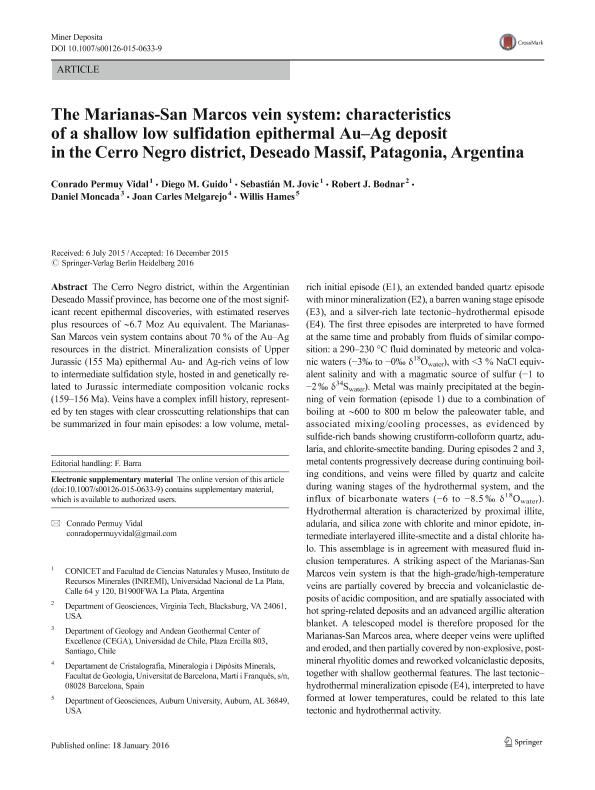Artículo
The Marianas-San Marcos vein system: characteristics of a shallow low sulfidation epithermal Au-Ag deposit in the Cerro Negro district, Deseado Massif, Patagonia, Argentina
Permuy Vidal, Conrado ; Guido, Diego Martin
; Guido, Diego Martin ; Jovic, Sebastian Miguel
; Jovic, Sebastian Miguel ; Bodnar, Robert J.; Moncada, Daniel; Melgarejo, Joan Carles; Hames, Willis
; Bodnar, Robert J.; Moncada, Daniel; Melgarejo, Joan Carles; Hames, Willis
 ; Guido, Diego Martin
; Guido, Diego Martin ; Jovic, Sebastian Miguel
; Jovic, Sebastian Miguel ; Bodnar, Robert J.; Moncada, Daniel; Melgarejo, Joan Carles; Hames, Willis
; Bodnar, Robert J.; Moncada, Daniel; Melgarejo, Joan Carles; Hames, Willis
Fecha de publicación:
08/2016
Editorial:
Springer
Revista:
Mineralium Deposita
ISSN:
0026-4598
e-ISSN:
1432-1866
Idioma:
Inglés
Tipo de recurso:
Artículo publicado
Clasificación temática:
Resumen
The Cerro Negro district, within the Argentinian Deseado Massif province, has become one of the most significant recent epithermal discoveries, with estimated reserves plus resources of ∼6.7 Moz Au equivalent. The Marianas-San Marcos vein system contains about 70 % of the Au–Ag resources in the district. Mineralization consists of Upper Jurassic (155 Ma) epithermal Au- and Ag-rich veins of low to intermediate sulfidation style, hosted in and genetically related to Jurassic intermediate composition volcanic rocks (159–156 Ma). Veins have a complex infill history, represented by ten stages with clear crosscutting relationships that can be summarized in four main episodes: a low volume, metal-rich initial episode (E1), an extended banded quartz episode with minor mineralization (E2), a barren waning stage episode (E3), and a silver-rich late tectonic–hydrothermal episode (E4). The first three episodes are interpreted to have formed at the same time and probably from fluids of similar composition: a 290–230 °C fluid dominated by meteoric and volcanic waters (−3‰ to −0‰ δ 18 O water ), with <3 % NaCl equivalent salinity and with a magmatic source of sulfur (−1 to −2 ‰ δ 34 S water ). Metal was mainly precipitated at the beginning of vein formation (episode 1) due to a combination of boiling at ∼600 to 800 m below the paleowater table, and associated mixing/cooling processes, as evidenced by sulfide-rich bands showing crustiform-colloform quartz, adularia, and chlorite-smectite banding. During episodes 2 and 3, metal contents progressively decrease during continuing boiling conditions, and veins were filled by quartz and calcite during waning stages of the hydrothermal system, and the influx of bicarbonate waters (−6 to −8.5 ‰ δ 18 O water ). Hydrothermal alteration is characterized by proximal illite, adularia, and silica zone with chlorite and minor epidote, intermediate interlayered illite-smectite and a distal chlorite halo. This assemblage is in agreement with measured fluid inclusion temperatures. A striking aspect of the Marianas-San Marcos vein system is that the high-grade/high-temperature veins are partially covered by breccia and volcaniclastic deposits of acidic composition, and are spatially associated with hot spring-related deposits and an advanced argillic alteration blanket. A telescoped model is therefore proposed for the Marianas-San Marcos area, where deeper veins were uplifted and eroded, and then partially covered by non-explosive, post-mineral rhyolitic domes and reworked volcaniclastic deposits, together with shallow geothermal features. The last tectonic–hydrothermal mineralization episode (E4), interpreted to have formed at lower temperatures, could be related to this late tectonic and hydrothermal activity.
Palabras clave:
Argentina
,
Epithermal
,
Jurassic
,
Patagonia
,
Quartz Vein
Archivos asociados
Licencia
Identificadores
Colecciones
Articulos(CCT - LA PLATA)
Articulos de CTRO.CIENTIFICO TECNOL.CONICET - LA PLATA
Articulos de CTRO.CIENTIFICO TECNOL.CONICET - LA PLATA
Citación
Permuy Vidal, Conrado; Guido, Diego Martin; Jovic, Sebastian Miguel; Bodnar, Robert J.; Moncada, Daniel; et al.; The Marianas-San Marcos vein system: characteristics of a shallow low sulfidation epithermal Au-Ag deposit in the Cerro Negro district, Deseado Massif, Patagonia, Argentina; Springer; Mineralium Deposita; 51; 6; 8-2016; 725-748
Compartir
Altmétricas



